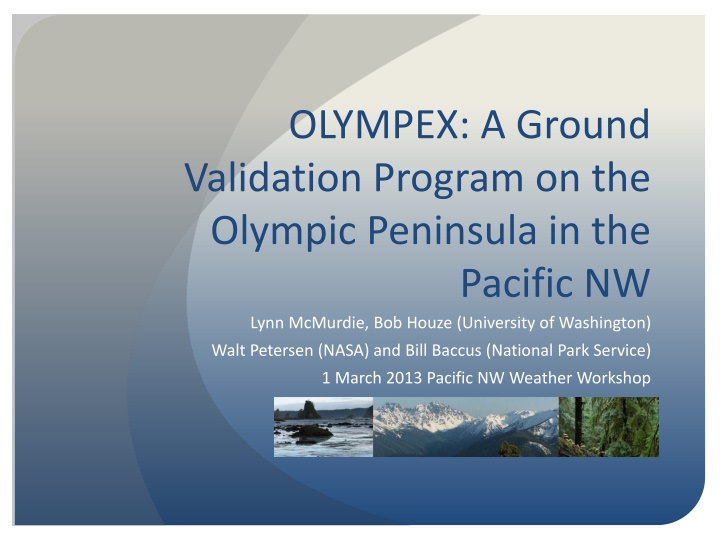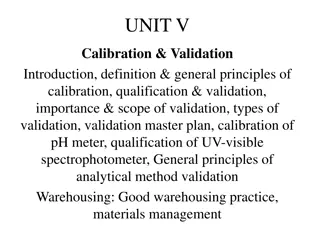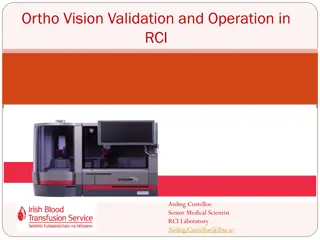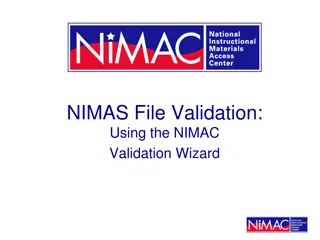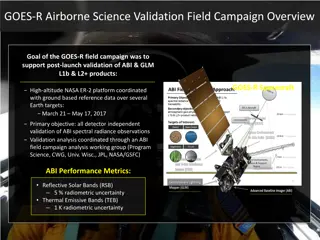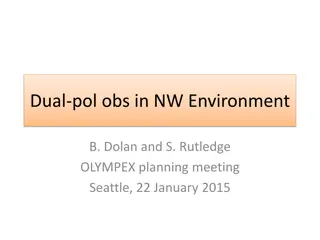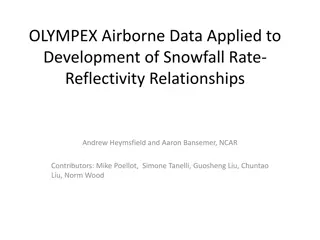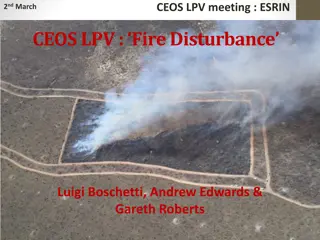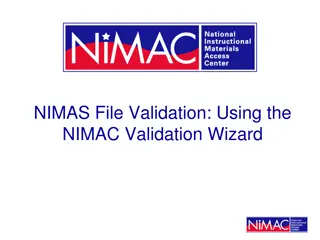OLYMPEX Ground Validation Program on the Olympic Peninsula
Conducted by experts from University of Washington, NASA, and National Park Service, the OLYMPEX program aims to validate satellite precipitation algorithms in the Pacific NW terrain. This includes testing in an environment with abundant rain, snow, and complex terrain transitioning from ocean to land. The program is associated with the GPM mission, which will utilize advanced instruments like the GMI and DPR to measure precipitation from space. The unique climatology of Olympic Peninsula, characterized by persistent southwesterly flow during winter, provides an ideal setting for such validation programs.
Download Presentation

Please find below an Image/Link to download the presentation.
The content on the website is provided AS IS for your information and personal use only. It may not be sold, licensed, or shared on other websites without obtaining consent from the author.If you encounter any issues during the download, it is possible that the publisher has removed the file from their server.
You are allowed to download the files provided on this website for personal or commercial use, subject to the condition that they are used lawfully. All files are the property of their respective owners.
The content on the website is provided AS IS for your information and personal use only. It may not be sold, licensed, or shared on other websites without obtaining consent from the author.
E N D
Presentation Transcript
OLYMPEX: A Ground Validation Program on the Olympic Peninsula in the Pacific NW Lynn McMurdie, Bob Houze (University of Washington) Walt Petersen (NASA) and Bill Baccus (National Park Service) 1 March 2013 Pacific NW Weather Workshop
A future field program to validate a future satellite In 2014 a new precipitation measuring satellite will be launched called the core satellite of the Global Precipitation Measurement (GPM) mission NASA is conducting several field programs to validate and develop the algorithms used by the instruments on the GPM One of these field programs will be on the Olympic Peninsula during water year 2015 2016. Most likely from Nov 2015 Jan 2016
What environment is good for testing precipitation algorithms? Lots of Rain Lots of Snow Complex Terrain with transition from ocean to coast to land
The GPM Satellite A polar orbiting satellite with an altitude of 407 km, a 65 orbit inclination, and a non sun-synchronous circular orbit dedicated to measuring precipitation from space. This means it will sample the earth from the Antarctic circle to the Arctic circle and will sample a particular spot on the earth at different times of the day. Prior precipitation satellite TRMM only measured tropical regions
The GMI (and the) DPR Instruments The Dual-Frequency Precipitation Radar (first time in space) Will detect the 3-D distribution of precipitation These frequencies will detect a range of precipitation regimes tropical intense rain to midlatitude light rain and snow Will have a swath width of 245 km (Ku band) and 120 km (Ka band) The GPM Microwave Imager Passive microwave instrument with low frequencies to measure rain and high frequencies to measure snow Prior instruments did not have the very high frequencies that will be on the GMI Will have a swath width of 904 km
Climatology of Olympic Peninsula Persistent southwesterly flow during the winter provides a reliable source of moisture NCEP long-term mean sea level pressure (mb) for winter (November to February) and topography
Climatology of Olympic Peninsula Maximum Annual average precipitation (PRISM) Extremely large precipitation accumulation produced as the moist Southwesterly flow impinges on coastal terrain
Climatology of Olympic Peninsula Precipitation varies between ridges and valleys and exhibits enhancement on the mountain ridges. Derived from a 5-year climatology of continuous mesoscale model results (MM5) and verified by precipitation gauges (Minder et al., 2008)
Typical Frontal Passage (from this past Sunday evening as seen by the coastal radar LGX) SW side of Olympics gets rain well ahead of front SW side gets rain during front SW side gets post-frontal showers
Climatology of Olympic Peninsula Frequency of occurrence 0 C level The mean 0 C level is low so that there is rain at low elevations and snow at high elevations Distribution of Nov-Jan 0 C level for flow that is onshore and moist at low levels (KUIL sounding). Mean 0 C level during storms = 1.5 km See this full range in individual storms! (plot provided by Justin Minder)
Resources and Experience in the Region 1965-2000: Cascade Project, CYCLES, COAST 2001: IMPROVE field experiment Ongoing: Regional Environmental Prediction (MM5/WRF)
OLYMPEX: Current Instrumentation Ground Measurements Detailed gauge network SNOTEL RAWS sites COOP site Current surface measurements of meteorological parameters at RAWS, COOP sites and at Quillayute (KUIL) Soundings at KUIL Snow measurements at SNOTEL sites (Buckinghorse closest to wet side) Tipping bucket rain gauges deployed now along transect between the Quinault and Queets rivers and one at the coast (as in Minder et al. 2008). Network has been on site since ~2004
OLYMPEX: Current Instrumentation Radar The celebrated and much beloved coastal radar Langley, WA (LGX) since 2011 Atmospheric River Observatory at Westport, WA since 2009: 915 MHz Wind Profiling Radar Atmospheric River S-Band Precipitation Radar Langle y Westport
OLYMPEX: Proposed Instrumentation Ground-based Additional Rain gauges, especially in Chehalis Basin Snow Measurements hot plates, Pluvio precipitation gauge, snow video imager Video disdrometer River gauges?
OLYMPEX: Proposed Instrumentation Radar and Aircraft DC-8 Global Hawk Npol in RHI Mode and maybe another radar? DC-8 and/or Global Hawk will fly instruments similar to those on the satellite DC-8 and/or other aircraft with microphysics instruments Npol
OLYMPEX: Promises and Challenges The Olympic Peninsula is a natural laboratory for precipitation studies Frequency of Occurrence Freezing level in KM o Persistence of moist flow o Huge precipitation amounts o Complex terrain o Low freezing level
OLYMPEX: Promises and Challenges The Olympic Peninsula is a natural laboratory for precipitation studies Builds on strong past experience in area and existing and planned resources o Past field programs (CYCLES, COAST, IMPROVE, etc.) o Coastal Radar, Atmospheric River Observatory, surface precip gauges o NPOL, aircraft, additional snow/rain gauges Npol
OLYMPEX: Promises and Challenges The Olympic Peninsula is a natural laboratory for precipitation studies Builds on strong past experience in area and existing and planned resources Science Goals o Physical validation of algorithms o Rain and snow studies in complex terrain o Hydrological applications of the GPM measurements o Modeling studies: microphysics from models and data assimilation of GPM precipitation estimates
OLYMPEX: Promises and Challenges The Olympic Peninsula is a remote area o Much of region in Nat l Park or Nat l Forest land o Difficult to install, get power and maintain instruments
OLYMPEX: Promises and Challenges The Olympic Peninsula is a remote area Very challenging for satellite algorithms o Mixed phase precipitation o Transition ocean/coast/land o Complex terrain Challenging, but not impossible o GPM and other constellation satellites promises to be able to monitor all ranges of precipitation (light to intense) globally on many time scales (hours to daily to inter-annual) o Results from OLYMPEX will help GPM fulfill that promise Funding provided by NASA award: NNX12AL54G
